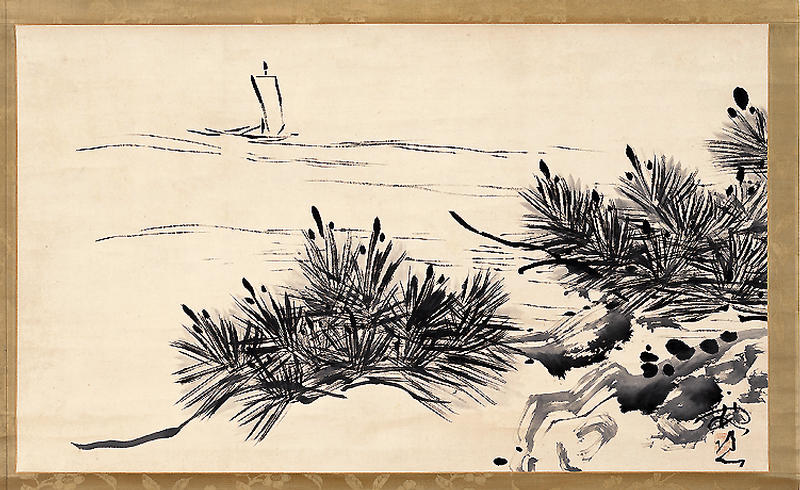青松白帆図(池大雅筆)
- 江戸時代中期
- 18c
- 紙本墨画
- H-53.7 W-90.8
江戸時代 18世紀
紙本墨画
縦:53.7cm 横:90.8cm
松の姿を極めて近づけて描く,いわゆる近接拡大図法を用いている。しかも,それを横長の画面のなかに構図するという大胆な発想が,ある意味では大雅らしいとも言えよう。
池大雅(1723~76)は日本南画の巨星というべき画家だが,いわゆる文人画家臭とはほど遠い人であった。文人画風にひたすら拘泥するという態度をとることなく,常に新しい絵画的視覚を取り入れることに意を尽くした。洋風表現もその一つである。大雅が西洋から渡来した銅版風景画に非常な興味を示したという逸話は有名だが,「朝熊山真景図」などはそうした逸話の蓋然性を高めるだろう。
本図のごとき近接拡大の構図法も,大雅の洋画的視覚の吸収のあととみることができるだろう。款記「霞樵」朱文楕円形連印「霞樵」。 (狩野)
Catalogue Entry
by Ike-no-Taiga
Edo period, 18th century
Hanging scroll, ink on paper
Height, 53.7cm; width, 90.8cm
A pine tree is depicted in the immediate foreground of this painting, using the so-called "close-up" compositional technique. This close-up representation is then further heightened by the broad expanse of a horizontal format, a bold, imaginative form that can be considered quintessentially Taiga-esque.
Ike-no-Taiga (1723-76) was a painter known as one of the greats of Japanese literati painting, and yet he kept himself removed from an aloof literati painter stance. He did not insist on a strict adherence to a purely literati painting style, but rather was always intent upon bringing new painterly insights and viewpoints into his work. Western-style painting expression was one such viewpoint. There are famous anecdotes regarding Taiga's fascination with the landscape engravings brought to Japan from the West, and the veracity of such tales is confirmed by Taiga's "true-view" realistic depictions, such as his True View of Mt. Asama.
The extreme "close-up" technique found in the present work might also be seen as an expression of Taiga's acceptance of a western painterly viewpoint. Signed "Kasho" with a red letter linked-oval seal "Kasho." HK
